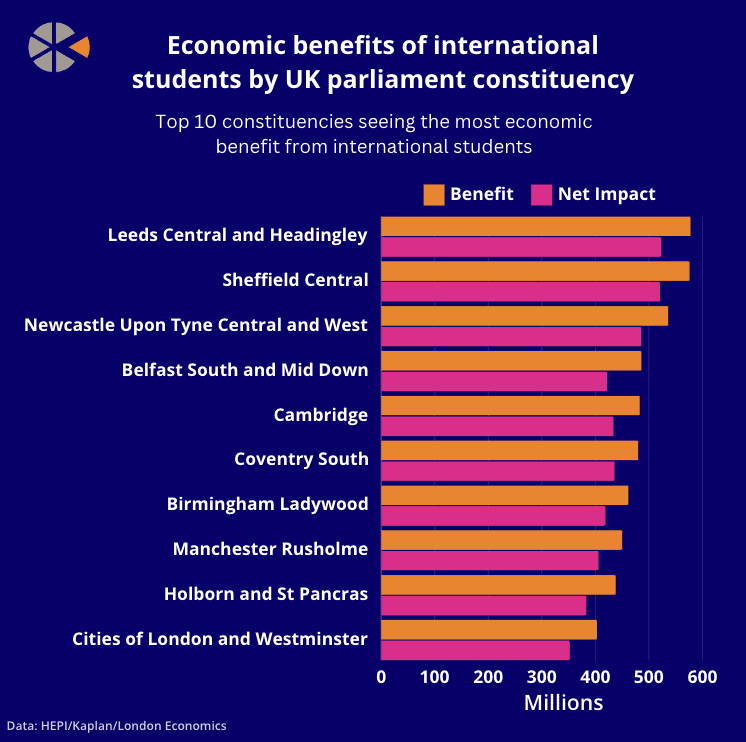It has been called some of the most “accurate, up-to-date and more useful” than any data published before on international students’ benefit to the country, and all 650 constituencies have been evaluated.
The constituency seeing the most economic benefit with £578m from internationals is Leeds Central and Headingley. With 5,585 first year internationals, its net impact sits at £523m – and leaves each of the population £4,930 better off.
Some five universities are situated in Leeds, including the University of Leeds and Leeds Beckett, possibly explaining the volume of international student economic benefit.
Also in the top ten is Holborn and St Pancras, a parliamentary seat that Sir Keir Starmer – the Labour party’s leader – is campaigning to retain at the July 4 general election.
Constituents see a £438m benefit from international students, with the net impact, factoring in their costs, at £383m.
The only constituency not in England in the top 10 is Belfast South and Mid Down – the location of Queen’s University Belfast and Ulster University – with an economic benefit of £486m and a net impact of £422m.
Linda Cowan, managing director at Kaplan International Pathways, which along with HEPI and London Economics put together the research, reiterated the importance of data surrounding international students – and the importance of signalling.
“With growing competition for international students from countries with world leading institutions, it has never been more important to send a consistent and unambiguous message of welcome to international students,” she said.
Nick Hillman, director of HEPI, called the numbers astounding.

“In a small handful of individual constituencies, each year’s new group of international students brings in over half a billion pounds a year. At the other end of the scale, there are around 100 constituencies where international students are worth less than £10 million,” he noted.
Down at the bottom of the table is North Norfolk, which has a net impact of just £2m.
Just outside the bottom ten, however, is Clacton – where Reform UK leader Nigel Farage is standing on the mandate of bringing down net migration in a dramatic fashion, as he fights to win a seat in parliament for the seventh time.
The benefits brought by international students per constituent in Clacton is just £40, with a net impact of £4m.
Hillman said the information would be shared directly with election candidates from all political parties across the country, “so they can see the benefits” and – more importantly – “opportunities for their areas”.
We hope that the incoming Government, and every newly elected MP in every constituency, will pay close attention to these findings
James Cannings, London Economics
Incumbent Prime Minister Rishi Sunak fights to retain his seat in another constituency with a markedly low economic benefit from international students – the benefits total around £8m, with the net impact at £7m.
Liberal Democrat leader Ed Davey’s seat is 91st in the table, with economic benefits totalling £146m and a net impact of £127m in Kingston and Surbiton.

“We hope that the incoming government, and every newly elected MP in every constituency, will pay close attention to these findings – both for the sake of the financial sustainability of the higher education sector, but also for the growth of the UK economy as a whole,” said James Cannings, senior economic consultant and London Economics.
HEPI noted that this is the most intricate set of data on the constituency level, with past publications having “limitations” including the use of the location of “all students as a proxy for where international students live”.
“The new data being published now are based instead on the number of non-UK born full-time students aged 18+ in England, Wales, and Northern Ireland in each area, as recorded in the 2021 Census, and they reflect the revised constituency boundaries,” HEPI noted.
“Using updated and more granular census data than previously available and applying it to the new Westminster parliamentary constituencies, this important analysis provides the most accurate picture yet of the net economic impact of international students,” noted Cowan.





